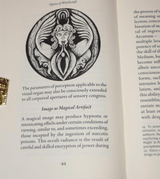Search Results
7/19/2025, 3:24:26 PM
>>40755961
>Despite ancient religious bans upon idols and their worship, the Holy Images of the gods persisted in the inheritors of Rome, itself a great reservoir of effigy and idol magic. The 'triumph' of Christianity over older religious imagery was dealt a blow in the early Renaissance by the rediscovery of ancient pagan iconography in subterranean grottoes, and its gradual incorporation in the design elements of gardens , architecture, visual and literary art.17 Whilst the Gods of Old Rome and Greece were not officially revived in religious cults, the surface images of European culture suggested precisely the opposite, intimating an ingression of ancient power, via aesthesis, into the art and magical philosophy of the present. Embodied in these images were attributes of divinity absent in Christianity, particularly nudity, romantic sexuality, license, fertility, and the virtues of wildness. Thus was the outpouring of sexualized 'pagan' imagery permitted in the context of ornamentation and philosophical contemplation, even whilst Protestant iconoclasm raged during the Reformation
i think this quote speaks to the sort of deity ishtar even is. a theme ive seen recur on /inana/ is that of embracing desire and in some of ishtar’s hymns u see a motion towards the embrace of sexuality. behind these icons is the transmission of a greater pagan ethos
this takes me also to how all of this can be related to what ishtar is as a being. i keep fixating on the fact that she is both a goddess of love and war, because it is a very productive contradiction. we may also think of her as a goddess of beauty and strife. while beauty has of course an immediate connection to art, we can also see that Beauty is the Good qua manifestation.
>Despite ancient religious bans upon idols and their worship, the Holy Images of the gods persisted in the inheritors of Rome, itself a great reservoir of effigy and idol magic. The 'triumph' of Christianity over older religious imagery was dealt a blow in the early Renaissance by the rediscovery of ancient pagan iconography in subterranean grottoes, and its gradual incorporation in the design elements of gardens , architecture, visual and literary art.17 Whilst the Gods of Old Rome and Greece were not officially revived in religious cults, the surface images of European culture suggested precisely the opposite, intimating an ingression of ancient power, via aesthesis, into the art and magical philosophy of the present. Embodied in these images were attributes of divinity absent in Christianity, particularly nudity, romantic sexuality, license, fertility, and the virtues of wildness. Thus was the outpouring of sexualized 'pagan' imagery permitted in the context of ornamentation and philosophical contemplation, even whilst Protestant iconoclasm raged during the Reformation
i think this quote speaks to the sort of deity ishtar even is. a theme ive seen recur on /inana/ is that of embracing desire and in some of ishtar’s hymns u see a motion towards the embrace of sexuality. behind these icons is the transmission of a greater pagan ethos
this takes me also to how all of this can be related to what ishtar is as a being. i keep fixating on the fact that she is both a goddess of love and war, because it is a very productive contradiction. we may also think of her as a goddess of beauty and strife. while beauty has of course an immediate connection to art, we can also see that Beauty is the Good qua manifestation.
Page 1
